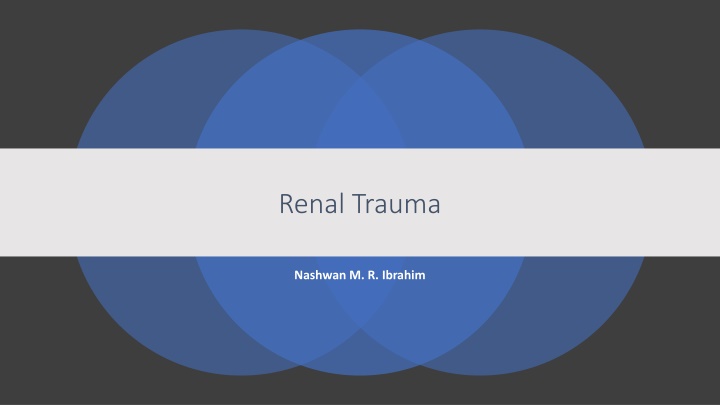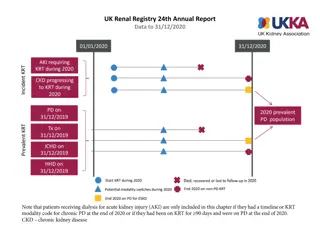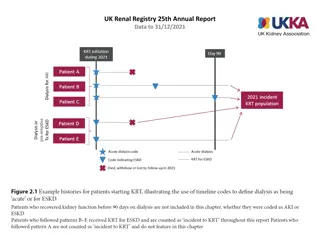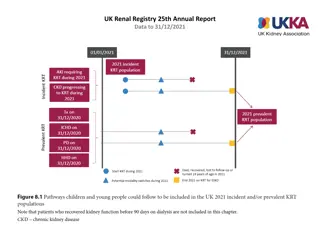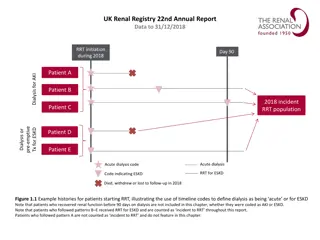Renal Trauma: Causes and Classification
The kidneys are well-protected but can still sustain injuries, particularly from blunt trauma or penetrating wounds. Renal trauma is relatively common and can vary in severity, classified from minor contusions to major vascular injuries. Prompt recognition and appropriate management are essential in these cases.
Download Presentation

Please find below an Image/Link to download the presentation.
The content on the website is provided AS IS for your information and personal use only. It may not be sold, licensed, or shared on other websites without obtaining consent from the author.If you encounter any issues during the download, it is possible that the publisher has removed the file from their server.
You are allowed to download the files provided on this website for personal or commercial use, subject to the condition that they are used lawfully. All files are the property of their respective owners.
The content on the website is provided AS IS for your information and personal use only. It may not be sold, licensed, or shared on other websites without obtaining consent from the author.
E N D
Presentation Transcript
Renal Trauma Nashwan M. R. Ibrahim
The kidney is well protected by heavy lumbar muscles, vertebral bodies, ribs, and the viscera anteriorly. Renal trauma occurs in approximately 1-5% of all traumas. Renal injuries are the most common injuries of the urinary system. Blunt trauma directly to the abdomen, flank, or back is the most common mechanism, accounting for 80-85% of all renal injuries. Background Kidneys with existing pathologic conditions such as hydronephrosis or malignant tumors are more readily ruptured from mild trauma.
1. Blunt Trauma: may result from motor vehicle accidents, fights, falls, and contact sports. Fractured ribs and transverse vertebral processes may penetrate the renal parenchyma or vasculature. 2. Vehicle collisions at high speed: may result in major renal trauma from rapid deceleration and cause major vascular injury. Mechanism of injury 3. Penetrating injuries: mostly caused by Gun-shot and knife wounds; any such wound in the flank area should be regarded as a cause of renal injury until proved otherwise.
grade II: superficial cortical laceration <1 cm, non-expanding perirenal haematoma confined to retroperitoneum grade I: contusion or non- subcapsular perirenal haematoma subcapsular perirenal haematoma enlarging subcapsular perirenal haematoma, and no laceration Classification of renal injuries grade IV laceration extends to renal pelvis with urinary extravasation vascular: injury to main renal artery or vein with contained haemorrhage segmental infarctions without associated lacerations expanding subcapsular haematomas compressing the kidney grade III: laceration >1 cm without extension into the renal pelvis or collecting system (no evidence of urine extravasation) grade V devascularisation of a kidney due to hilar injury shattered kidney avulsion of renal hilum: devascularisation of a kidney due to hilar injury ureteropelvic avulsions complete laceration or thrombus of the main renal artery or vein devascularisation of a kidney due to hilar injury
Minor renal trauma (85% of cases)- (grade 1-3) Renal contusion or bruising of the parenchyma is the most common lesion. Subcapsular hematoma in association with contusion is also noted. Superficial cortical lacerations are also considered minor trauma. These injuries rarely require surgical exploration. Major renal trauma (15% of cases)-(grade 4&5) Deep corticomedullary lacerations may extend into the collecting system, resulting in extravasation of urine into the perirenal space. Large retroperitoneal and perinephric hematomas often accompany these deep lacerations. Multiple lacerations may cause complete destruction of the kidney. Laceration of the renal pelvis without parenchymal laceration from blunt trauma is rare. Classification of renal injury Vascular injury (about 1% of all blunt trauma cases)-(grade 4&5) Vascular injury of the renal pedicle is rare but may occur, usually from blunt trauma. There may be total avulsion of the artery and vein or partial avulsion of the segmental branches of these vessels. Vascular injuries are difficult to diagnose and result in total destruction of the kidney unless the diagnosis is made promptly.
Hematuria is a sign of damaged kidney. Delayed hematuria may occur 3 days to 3 weeks after injury ( clot dislodgement) Pain in lumbar region on the side of damage is observed in 80- 95 % of cases of isolated traumas of kidney and in 10-20 % of combined injuries. It is dull or acute with irradiation in inguinal region or external sexual organs. Symptoms Retroperitoneal bleeding and hematoma may cause Meteorism (abdominal distention, ileus, nausea and vomiting) 24 -48 hours after injury. Associated injuries such as ruptured abdominal viscera or multiple pelvic fractures also cause acute abdominal pain and may obscure the presence of renal injury.
Hematuria Signs The following findings on physical examination may indicate possible renal involvement : Flank pain Flank ecchymosis and bruisings. Fractured ribs Abdominal distension Abdominal mass Abdominal tenderness
Bruising after blunt renal injury
Initial emergency assessment 1. 2. 3. Securing of the airway Controlling any of the external bleeding Resuscitation of shock Management 4. Physical examination is carried out during stabilization
Urine from a patient with suspected renal injury should be inspected grossly and then by dipstick analysis for hematuria. Blood sample should be sent for blood grouping and serum saved for cross matching. Serial hematocrit measurement indicates blood loss ( renal or associated injuries ? ) Creatinine measurement reflects renal function prior to the injury. Laboratory Investigations
1. Blunt trauma patients with hematuria (macroscopic or microscopic) with hypotension (systolic blood pressure < 90 mmHg ). Indications of radiographic evaluation 2. All patients with a history of rapid deceleration injury and /or significant associated injury. All patients with any degree of hematuria after penetrating abdominal or thoracic injury require urgent renal imaging. 3.
Ultrasonography can be informative during the primary evaluation of polytrauma patients and for the follow-up of the recuperating patients. A CT scan with enhancement of intravenous contrast material and delayed film ( after 10 minute) is the best imaging study for diagnosis and staging renal injuries in hemodynamically stable patients. Radiological investigations Unstable patients who require emergency surgical exploration should undergo a one-shot IVP with bolus intravenous injection of 2ml/kg (double dose) contrast. Angiography can be used for diagnosis and simultaneous selective embolization of bleeding vessels.
Grade I injury (subcapsular hematoma)
Grade II injury
Grade IV injury
Grade III injury
Grade 5 injury
Non-operative management is the treatment of choice for the majority of renal injuries Conservative watchful treatment of closed renal trauma is usually successful. The overall exploration rate for blunt trauma is less than 10% The overall rate of patients who have a nephrectomy during exploration is around 13% Treatment
Stable patients following grade 1-4 blunt renal trauma , should be managed conservatively. Conservative treatment Stable patients , following grade 1-3 stab and low velocity-gunshot wounds after complete staging , should be selected for expectant management
Conservative management is successful in most cases. We try to avoid surgical exploration because: Exploration of the kidney may be associated with massive blood loss as the hematoma is opened Nephrectomy is a possibility so it is important to establish that the contralateral kidney is functioning
Intravenous access should be established.Blood should be cross-matched for transfusion if there is evidence of hypovolaemic shock or continuing haemorrhage.. The patient should stay in bed while there is macroscopic haematuria and activity must be curtailed for a week after the urine clears. Conservative management Morphine analgesia may be appropriate. Hourly pulse and blood pressure charts must be kept. Antibiotics should be given to prevent infection of the haematoma.
Haemodynamic instability Surgical treatment Indications for surgical management include : Exploration for associated injuries Expanding or pulsatile perirenal hematoma identified during laparotomy A grade V injury Incidental finding of pre-existing renal pathology requiring surgical therapy Development of complications that require surgical treatment ( Perinephric abcess)
Renal reconstruction should be attempted in cases where the primary goal of controlling hemorrhage is achieved and sufficient amount of renal parenchyma is viable. If the kidney is completely destructed or there is uncontrollable life threatening bleeding then nephrectomy provided the other kidney. Surgical treatment When a solitary kidney is sufficiently damaged to need exploration, it must be repaired. Failing this, the wound is packed firmly with gauze to stop the bleeding in the hope that some renal function may be retained when the ruptured kidney heals.
Bleeding (clot retention). Infection and perinephric abscess. Sepsis. Early Complications Urinary extravasation and urinoma. Hypertension. Urinary fistula.
Bleeding. Hydronephrosis. Calculus formation. Delayed complications Chronic pyelonephritis. Hypertension. Arteriovenous fistula. Psuedoaneurism of the renal artery.
Trauma to the ureters is relatively rare because they are protected from injury by their small size, mobility, and the adjacent vertebrae, bony pelvis, and muscles. Ueteral trauma accounts for 1-2.5% of urinary tract trauma.
Etiology 1. Blunt trauma: hyperextension injury to the spine, or avulsion of the ureter from PUJ in deceleration injuries. 3. Iatrogenic: 2. Penetrating trauma: stab wound or gunshot. Most common cause During uretroscopic surgery or basket manipulation of calculi During difficult pelvic surgery.
Injury to one or both ureters during pelvic surgery This occurs most often during vaginal or abdominal hysterectomy (the ureter is divided, ligated, crushed or excised, usually inadvertently). Large pelvic mass ( benign or malignant) may engulf and involve or displace the ureter laterally which may lead to ureteral injury during surgery.
Types of injury 1. Ligation with suture. 2. Crushing 3. Transection ( complete or partial) 4. Angulation (kinging) 5. Diathermy related injuries. 6. Resection. 7. Ischemia from devascularization. Injury specially occurs if there is bleeding or in distorted anatomy.
Diagnosis of ureteral injury the venial sin is the injury to the ureter; The mortal sin is failure of recognition Unfortunately only 1/3 of ureteral injuries are diagnosed intraoperatively. By: 1. Directly visualizing. 2. Extravasation of urine. 3. Ureter become dilated (if distal obstruction) 4. Dye test (methylene blue or indigo carmine given I.V)
1. No symptoms. Secure ligation of a ureter may simply lead to silent atrophy of the kidney. Injury not diagnosed at the time of surgery; there are 3 possibilities: 2. Loin pain and fever( in the postoperative period), possibly with pyonephrosis, occur with infection of the obstructed system. 3. A urinary fistula develops through the abdominal or vaginal wound.
Symptoms (postoperative period) Hematuria. Flank pain with nausea and vomiting. Anuria ( single kidney or bilateral ureteric ligation). Vaginal or drain urinary leakage. Fever. Abdominal distention or unusual delay in return of bowel function. Uremia.
Signs Unexplained fever, ileus/peritonitis. Ascites Urine draining from vagina, drain or incision site ( creatinine concertation in urine is very high compared to serum). Retroperitoneal mass (Urinoma).
Investigations Laboratory: 1.Microscopic hematuria. 2.leukocytosis. 3. Elevated renal function. Diagnosis is by Excretory Urography or contrast enhanced CT scan (with delayed films). Ultrasound shows hydronephrosis or Urinoma development.
Depends on the timing of discovering the injury and general condition of patient. If the injury is diagnosed intraoperatively or in the early postoperative period and the patient condition is stable immediate repair. Treatment If the patient condition is unstable then temporary urine diversion by nephrostomy followed by repair.
Ureter repair options Upper ureteric injury: either 1. Primary anastomosis by ureteroureterostomy. 2. Ileal interposition. 3. Auto transplantation. Mid ureteric injury: 1. Primary anastomosis by ureteroureterostomy. 2.trans uretero-ureterostomy. Lower ureteric injury : Reimplantation of ureter. ( Psous Hitch or Boari flap)
Is a common urological injury The bony pelvis protects the bladder very well; when the pelvis is fractured by trauma, fragments of the fracture may penetrate the bladder. 15% of pelvic fractures are associated with bladder injury. Distended bladder at the time of accident is more liable for injury.
Types 1. Extraperitoneal rupture (80%). 90% of cases are associated with pelvic fracture,. 1. Intraperitoneal injury (20%).
Etiology Blunt trauma: 1. direct blow to abdomen (leading to intraperitoneal rupture). 2. Motor vehicle accidents, falls and industrial trauma ( usually extraperitoneal and associated with pelvic bone fracture). Penetrating bladder injuries: gunshot wounds and stab wounds. Iatrogenic injuries: The bladder is the urological organ that most often suffers iatrogenic injury, mainly during gynecologic and urologic procedures.
Presentation Gross hematuria is the cardinal sign ( associated with 90% of bladder injuries). Hematuria with pelvic fracture indicates bladder injury until proved otherwise. Lower abdominal pain, distention and tenderness ( extraperitoneal). Inability to urinate or difficulty in voiding. Acute abdomen (severe abdominal pain, distention and rigidity) with intraperitoneal rupture.
Diagnosis Plain X-ray of the abdomen pelvic bone fracture, there may be haziness over the lower abdomen from blood and urine extravasation.. retrograde Cystography; is the investigation of choice for diagnosis and classification of bladder injury. CT cystogram. Foly s catheterization is contraindicated if there is bladder at the meatus ( Urethral injury)..
Extrapertoneal rupture shows a flame-shaped density adjacent to right lateral wall of bladder
Intraperitoneal rupture extraluminal contrast (red arrows) outside the confines of the normal bladder and spreading into the peritoneal cavity. There is contrast in the left paracolic gutter (yellow arrow), not within the bowel. The intrarenal collecting systems and ureters are visualized because the patient had a contrast enhanced CT done moments earlier
Treatment Intraperitoneal rupture; should be treated immediately with laparotomy and repair of the bladder. Extraperitoneal rupture ; treatment is usually by folly's catheterization ( for 7-14 days) and antibiotic cover. If there is an extensive urinoma or development of infection or bone fragment penetrating the bladder then surgical repair.
